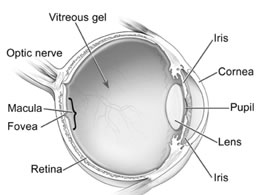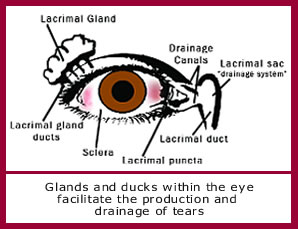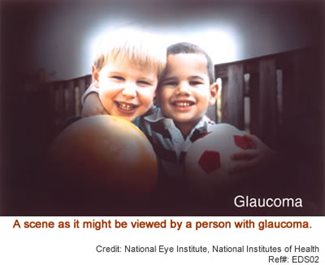Why are regular eye exams important?
Many eye experts disagree on how often patients should have their eyes examined, but there is no disagreement that everyone should have a regular eye exam that includes both vision testing and an eye health evaluation.
Vision testing and correcting decreased vision with lenses (eyeglasses or contact lenses) is a key component to a comprehensive eye exam. It is essential that an eye doctor determines what lens prescription will provide a patient with “perfect vision” (20/20 vision). If a patient’s best vision with lenses is reduced, additional testing is required to understand why.
In addition to determining the patient’s prescription (refractive error), a comprehensive eye exam should also determine how well both eyes work together.
Testing to determine if the patient’s eyes are aligned is important. Some patients have crossed eyes or turned eyes, suggesting that the two eyes are not working together (strabismus). Strabismus can lead to poor depth perception and the inability to achieve “perfect vision” (20/20), also known as amblyopia.
Testing to determine if the two eyes are working efficiently as a “team” is an essential part of an eye exam. When the eyes do not work well together, problems such as headaches and eyestrain can affect reading and other near tasks. These eye teaming problems can be troublesome for school age children where reading is important to academic achievement. The comprehensive eye exam should also include testing that will assess focusing skills in children and adults. In adults (starting around 40 years of age) the eye’s ability to focus up close begins to decrease (presbyopia). Presbyopia is not serious, but only the correct prescription will help.
Checking eye health is an essential part of a vision exam and can reveal important information including the following:
Knowing a patient’s internal eye pressure can determine if a patient is at risk for developing glaucoma. Glaucoma, a painless disease, can lead to loss of vision if not treated and is more prevalent in African Americans.
Examining the retinal blood vessels provides a “snapshot” of how diseases like diabetes and high blood pressure are affecting blood vessels throughout the body. This information, when conveyed to a patient’s medical doctor can be quite valuable in how the patient is medically managed.
A yearly eye exam is a good idea, but some believe annual exams might be excessive. Consider the following when determining how often to see your eye doctor:
After 40 years old, having an eye exam every 18 to 24 months is a good idea. At around 60 years of age, annual exams should be considered because of the increased risk of developing cataracts, glaucoma, macular degeneration and other diseases of the aging eye.
Annual exams are absolutely necessary for patients with diabetes. If you have diabetic retinopathy (leaking retinal blood vessels in diabetics), more frequent exams may be necessary.
An annual exam and contact lens evaluation is necessary for contact lens’ wearers. The annual exam will ensure there are no unwanted effects of contact lens wear and make sure the contact lens prescription is up-to-date.
What are cataracts? How are they detected?
 Defined as a clouding of the lens of the eye, cataracts affect an individual’s vision. The lens is the clear part of the eye that helps focus light on an image on the retina. The retina sends signals to areas of the brain responsible for vision. The lens must be clear for the retina to receive a sharp image. If the lens is cloudy from a cataract, the image will be blurry. Because most cataracts are related to aging, they are common in older adults. Although cataracts are generally related to aging of the eye, other risk factors for cataracts are smoking, diabetes and ultraviolet light.
Defined as a clouding of the lens of the eye, cataracts affect an individual’s vision. The lens is the clear part of the eye that helps focus light on an image on the retina. The retina sends signals to areas of the brain responsible for vision. The lens must be clear for the retina to receive a sharp image. If the lens is cloudy from a cataract, the image will be blurry. Because most cataracts are related to aging, they are common in older adults. Although cataracts are generally related to aging of the eye, other risk factors for cataracts are smoking, diabetes and ultraviolet light.
- Cloudy or blurry vision
- Colors become faded
- Glare from lights or sunlight appears too bright
- A halo may appear around lights
- Poor night vision
- Double vision or multiple images in one eye
- Frequent changes in eyeglass prescription

Cataracts are detected through a comprehensive dilated eye exam. Early cataracts may be improved with a new eyeglass prescription, brighter lighting or magnifying lenses. Once the lens of the eye becomes too cloudy, a change in prescription may no longer be sufficient. Surgery (out patient) may be the only effective treatment, which involves removing the cataract and replacing it with an artificial lens. Surgery should only occur when vision loss interferes with everyday activities such as driving or reading.
When cataracts are mild, they often can be treated with a change in the spectacle prescription. However, once the lens of the eye becomes too cloudy, changes in the eyeglass prescription is no longer effective. At this point, cataract surgery is the best way to restore sight.
Surgery typically involves making a small incision in the front of the eye and removing the cataract. Through the same incision, a plastic lens is inserted into the eye. Healing time is typically one month or less.
Cataract removal is one of the most common operations performed in the United States. It is also one of the safest and most effective types of surgery. Post-surgical treatment involves using eye drops and maybe the use of a minor eyeglass prescription.
What are the signs & symptoms that might indicate a child has a vision problem?
When people are asked "what is the definition of good vision", the most common responses are:
"Good vision" is...
- the ability to see the small letters on a chart".
- seeing 20/20 on the vision chart at school or at the pediatrician".
Although there is some validity to these responses, good vision actually encompasses much more. Optometry believes good vision actually consists of three components, which are:
- The ability to see small detail (clarity)
- The ability to read or use the eyes for long periods of time without fatigue (comfort)
- The ability to analyze and interpret visual input (processing skills)
Conditions such as nearsightedness (myopia), farsightedness (hyperopia) and astigmatism can cause blurry vision. These conditions are usually easily treated with eyeglasses, which results in a restoration of clear vision. Having 20/20 vision is important. However, seeing clearly does not guarantee comfortable vision. There are many individuals who see very clearly yet find it difficult to read or concentrate for more than several minutes.
Many children can see clearly and may still have significant vision problems. When they are tested at school as part of the school vision screening, they pass. These children have vision problems which interfere with their ability to see comfortably.
Conditions such as eye teaming, eye focusing and tracking problems can cause discomfort associated with reading. If a child has difficulty controlling the coordination of his eyes, is unable to maintain focus or has difficulty aiming his eyes and scanning along a line of print, he/she may use extra effort to overcome these problems, leading to discomfort.
- Child complains of eyestrain and headaches
- Child complains of words moving on the page
- Tired at the end of the day
- Loses place often
- Must use finger or guide to keep place
- Skips lines and words often
- Poor reading comprehension
- Short attention span
The ability to analyze and interpret visual input is sometimes referred to as visual processing or visual perceptual skills. Optometrists believe this is an important aspect of vision, particularly for children in elementary school. Just because a child can see clearly and comfortably does not guarantee he/she will be able to make comprehend the incoming information.
These skills are important when a child is young and is learning letter and number recognition, reading and early math skills. In some children, the development of visual perceptual skills does not keep pace with the child's growth in other areas. This type of lag can lead to difficulty.
- Reverses letters and numbers
- Poor reading comprehension
- Poor recall of visually presented material
- Trouble with spelling and sight vocabulary
- Sloppy writing skills, erases excessively
- Trouble copying from board to book
- Can respond orally but not in writing
- Seems to know material but does poorly on written tests
If your child has any of the symptoms or behaviors listed above, he/she should have a full optometric vision evaluation designed to detect learning related vision problems. This examination goes way beyond the typical eye exam and looks for problems with clarity, comfort and processing. The Pediatric Department of The Eye Institute have doctors with advanced training, knowledgeable of working with children with learning related vision problems.
The doctors at the Pediatric Department of The Eye Institute will work along with the child’s school and teachers to rule out other possible problems. Once it is determined that the vision problem is important, a therapy program will be developed which may include glasses, office visits and computer-based home therapy.
What is vision therapy and when is it necessary?
Vision therapy is an individualized treatment program prescribed to eliminate or improve conditions such as lazy eye (amblyopia), focusing, eye teaming and learning related vision disorders. Special lenses, prisms, filters and instruments are used along with other specialized instruments and an advanced computer system.
There are a significant number of research studies supporting the effectiveness of vision therapy for the treatment of eye teaming, focusing, tracking and visual processing problems. In the last five years, there have been three randomized clinical trials published demonstrating office-based vision therapy should be the first line of treatment for these conditions.
The average program for focusing, eye teaming and tracking problems involves one to two office visits per week lasting 45 minutes each, and about 15 minutes of supportive home therapy 3 times per week using computer software. Many of theses problems can be eliminated in 15-20 visits. More complicated problems may require additional time.
Visual processing problems are more complicated and often require longer periods of therapy. Typical vision therapy for a learning related vision problem involving visual processing may require 30-40 visits of treatment.
Doctors of Optometry evaluate and treat patients who require vision therapy. Vision therapy is a sub-specialty of optometry. In the Vision Therapy Department here at the The Eye Institute, all of our doctors have completed residency training in vision therapy.
Some insurance companies will reimburse you for vision therapy services. To find out if your insurance company covers vision therapy, call and ask a representative if ORTHOPTIC THERAPY (92065) is covered. Our staff is trained to assist you in the processing of related forms and procedures.
Although most vision problems can be easily corrected using eyeglasses or contact lenses, some problems require more sophisticated treatment.
Problems such as eye teaming, focusing and tracking disorders are not optical and cannot be corrected with eyeglasses. Rather, they are muscle type problems and require vision therapy.
Visual processing problems interfering with a child’s ability to analyze and interpret visual information also require vision therapy.
Adults can also benefit from vision therapy if they are experiencing eyestrain, headaches and inability to perform well at work and have eye teaming and focusing problems. These problems commonly effect adults working with computers.
If after a routine eye examination, we find you may have a problem requiring vision therapy, you will be scheduled for a second examination. This examination will determine whether vision therapy is necessary. A fourth year intern under the supervision of residency trained optometrists administers vision therapy.
In addition to striving to achieve the highest possible success rates, our doctors attempt to solve the patient’s problem in as short a period of time as possible.
Allergic Conjunctivitis: What is it? What Can I Do About it?
Conjunctivitis is one of the most common and treatable eye conditions in children and adults. Often called “pink eye”, it is an inflammation of the conjunctiva, a clear, thin, membrane that covers the eyeball and lines the inside of the eyelids. Viruses, bacteria, irritating substances (for example: shampoo, dirt, smoke), or allergens (substances that cause allergies) can cause conjunctivitis. It is important to find out whether your pink eye is caused by allergies or infection, because each condition has different treatments.
Symptoms of allergic conjunctivitis may include:
- swelling of the eyelid
- redness in the white of the eye or inner eyelid
- increased amounts of tears (watery eyes)
- itchy eyes
- blurred vision
The symptoms will last as long as the allergen is around, whether its spring pollen or cat dander in a carpet.
Often there is no way to prevent allergic conjunctivitis. You can try to lessen your symptoms by limiting your exposure to allergens. For example, avoid going outside when the pollen counts are highest or when the wind is blowing allergens through the air. Use air conditioning rather than opening windows.
The best defense against allergic conjunctivitis is a good offense; try to avoid substances that trigger your allergies. Of course, in the case of pollen or animal dander, that may be impractical or impossible.
- There are a number of medicines that can provide symptomatic relief. They can help relieve itchy, watery eyes and may keep symptoms from returning. It is always preferable that an eye doctor make the most appropriate recommendation for the use of over-the-counter or prescription medicines.
- Besides topical eye drop treatments, there are additional ways to relieve the symptoms associated with allergic conjunctivitis. You can put cool compresses on your eyes several times a day to help relieve symptoms. You can also use artificial tear drops to both soothe the eyes and to wash away allergy-causing particles from the surface of the eye. (Ask your eye doctor to suggest an appropriate artificial tear drop.)
- Lastly, if you wear contact lenses, you should remove your lenses when your allergic symptoms are present.
Spring time can be a particularly difficult time for individuals who suffer from allergies due to the mold spores, dust, pollen, and other allergens that come with the season. Treating ocular allergy symptoms does not take a one-size-fits-all approach. There are many factors that go into getting the right treatment for your symptoms; furthermore, there are many different treatment approaches. However, finding the right treatment begins with the right diagnosis. The correct diagnosis begins with a visit to your eye doctor.
Dry Eye: Over 10 million Americans Have It… Are You One of Them?
 People with dry eyes experience many symptoms including irritated, gritty, scratchy, or burning eyes. Some people feel like there is something in their eyes. Patients with dry eyes may also experience excess watering and blurred vision.
People with dry eyes experience many symptoms including irritated, gritty, scratchy, or burning eyes. Some people feel like there is something in their eyes. Patients with dry eyes may also experience excess watering and blurred vision.
Smoky, windy and dry conditions can lead to symptoms of dry eye. Advancing age (especially in females) is one of the causes of dry eye. Additionally, many prescription and over the counter medications can also cause dry eye.
- Adding tears: Managing dry eyes include adding tears (often through using artificial tear drops).
- Conserving tears: An additional approach to treatment is blocking tear ducts through which tears drain.
- Increasing tear production: Prescription eye drops are also available to increase tear production.
- Treatment of contributing eyelid or ocular surface inflammation: Ocular inflammations can contribute to dry eye problems. Therefore, aggressive treatment for underlying inflammations with prescription drops or ointments may be necessary.
Once you have been diagnosed with dry eye, there are self-care steps to reduce symptoms:
- Remember to blink regularly when reading or staring at a computer screen for long periods of time.
- Increase the level of humidity in the area at work and at home.
- Wear sunglasses outdoors, particularly the wrap around frame design, to reduce exposure to drying winds and sun.
Use nutritional supplements containing essential fatty acids to decrease dry eye symptoms. Ask your eye doctor if dietary supplements would be helpful.
What is glaucoma? Are you at risk for it?
Glaucoma is a group of diseases that can damage the eye’s optic nerve. This may result in vision loss and ultimately blindness if left untreated. Glaucoma occurs when normal fluid pressure inside the eye (intraocular pressure) rises. Although there are various forms of glaucoma, nearly 90% of patients with this disease have primary open-angle glaucoma.
Over two million people in the United States have glaucoma. While anyone can be susceptible to developing this disease, some populations are much more likely to have glaucoma.
- Individuals with a family history of glaucoma
- Older adults
- African Americans are three times more likely than Caucasians to have glaucoma
- African Americans experience blindness from this disease four times more than other races
In addition to these risk factors, a comprehensive eye examination with dilating drops can reveal other possibly risk factors, such as elevated eye pressure and abnormal optic nerve appearance.
 At first, there are no symptoms associated with glaucoma. As a result, it’s often been characterized as a “silent disease.”
At first, there are no symptoms associated with glaucoma. As a result, it’s often been characterized as a “silent disease.”
Most of the time, with glaucoma patients, the eye appears normal and the individual experiences no pain. Vision remains unaffected until much later in the disease.
If glaucoma remains undiagnosed or untreated, peripheral (side) vision is affected first. Over time, the patient’s central (straight ahead vision) will also decrease, eventually leading to no vision at all.
Since most patients with glaucoma have no symptoms, the disease can only be detected by having routine eye examinations. The eye exam must include eye pressure checks and the use of eye drops to dilate a patient’s pupil in order to examine the back of the eye.
When first diagnosed, glaucoma is most often treated with eye drops to lower intraocular pressure (IOP). The drops act to reduce fluid production in the eye or help drain fluid from the eye. These drops may need to be taken several times a day. At times, more than one type of drop is required to control the eye pressure. If the eye pressure cannot be adequately controlled with eye drops, laser or surgical treatments may be necessary.
Blood Pressure:
The American Heart Association reported nearly one-third of adults in the country have high blood pressure. High blood pressure (hypertension) can lead to heart attacks, strokes, kidney disease and more. Medications, diet and exercise represent the foundation of medical treatment for this condition. When blood pressure is poorly controlled, it can lead to serious complications such as narrowing and leaking (hemorrhage) of the blood vessels in the eye (retinal blood vessels), or swelling of the retina or optic nerve. Singly or collectively, these retinal changes can seriously decrease vision.
- Normal Blood Pressure: 119/79 or lower
- Pre-hypertension: 120-139/80-89
- High Blood Pressure: 140/90 or higher
Cholesterol:
Elevated levels of fat (lipid/cholesterol) in the blood can contribute to serious health issues including coronary (heart) artery disease and stroke. Knowing ones’ total cholesterol and different types of cholesterol is important.
- Optimal Total Cholesterol: less than 200
- LDL (low density lipoprotein – “bad cholesterol”): Optimal: less than 100
